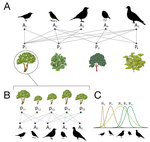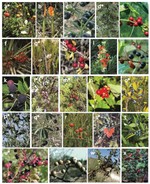Biogeography and evolution of plant biotic dispersal
10 January 2022
 Photo by P. Jordano
Photo by P. Jordano
We are assembling a comprehensive, global, dynamic, open, reproducible database of fruit and seed traits for all seed plants worldwide (called FRUSEED). These data will allow us to tackle long-standing questions on the prevalence, evolution and biogeography of animal-mediated (biotic) plant dispersal.
This research is funded by grant US-1381388 by Fondo Europeo de Desarrollo Regional (FEDER) and Consejería de Transformación Económica, Industria, Conocimiento y Universidades of Junta de Andalucía and Universidad de Sevilla, as well as grant CNS2022-135839 by MICIU/AEI/10.13039/501100011033 and European Union NextGenerationEU/PRTR.


Related
Publications
Downscaling mutualistic networks from species to individuals reveals consistent interaction niches and roles within plant populations
Species-level networks emerge as the combination of interactions spanning multiple individuals, and their study has received …
FRUGIVORY CAMTRAP: A dataset of plant–animal interactions recorded with camera traps
Ecological interactions are a key component of biodiversity, essential for understanding ecosystem services and functioning. Recording …
Villalba P, Arroyo-Correa B, Calvo G, Homet P, Isla J, Mendoza I, Moracho E, Quintero E, Rodriguez-Sanchez F, Jordano P
Lasting effects of avian-frugivore interactions on seed dispersal and seedling establishment
The consequences of plant–animal interactions often transcend the mere encounter stage, as those encounters are followed by a chain of …
Quintero E, Arroyo JM, Dirzo R, Jordano P, Rodriguez-Sanchez F
Masting is uncommon in trees that depend on mutualist dispersers in the context of global climate and fertility gradients
The benefits of masting (volatile, quasi-synchronous seed production at lagged intervals) include satiation of seed predators, but …
Qiu T, MASTIF network, Clark JS
Reciprocity and interaction effectiveness in generalised mutualisms among free-living species
Mutualistic interactions among free-living species generally involve weak links and highly asymmetric dependence among partners, yet …
Quintero E, Rodriguez-Sanchez F, Jordano P




